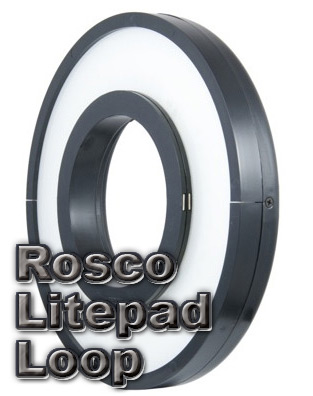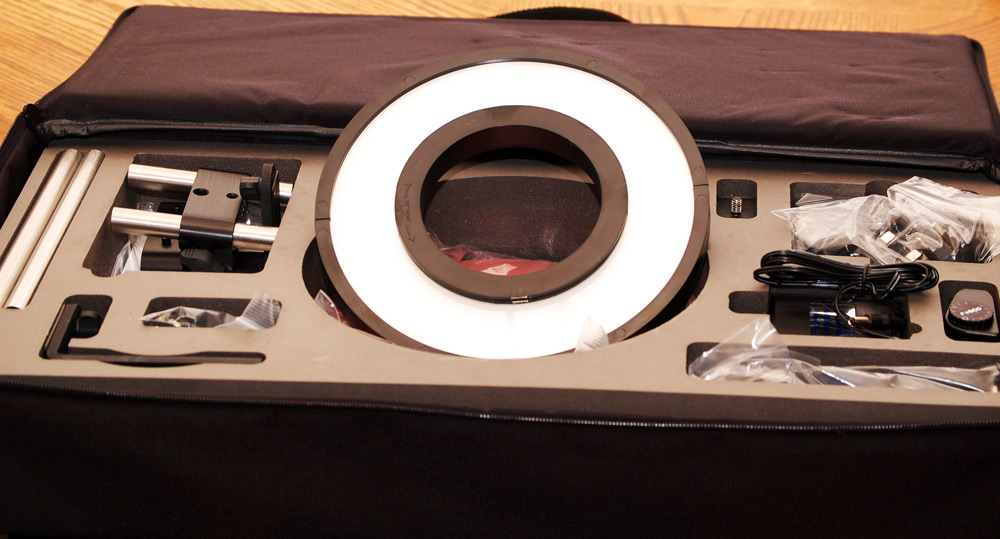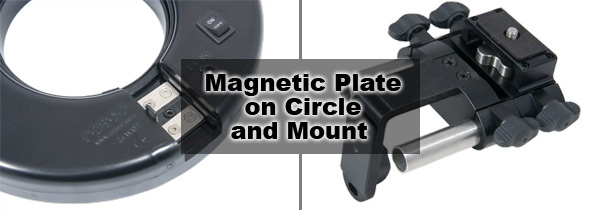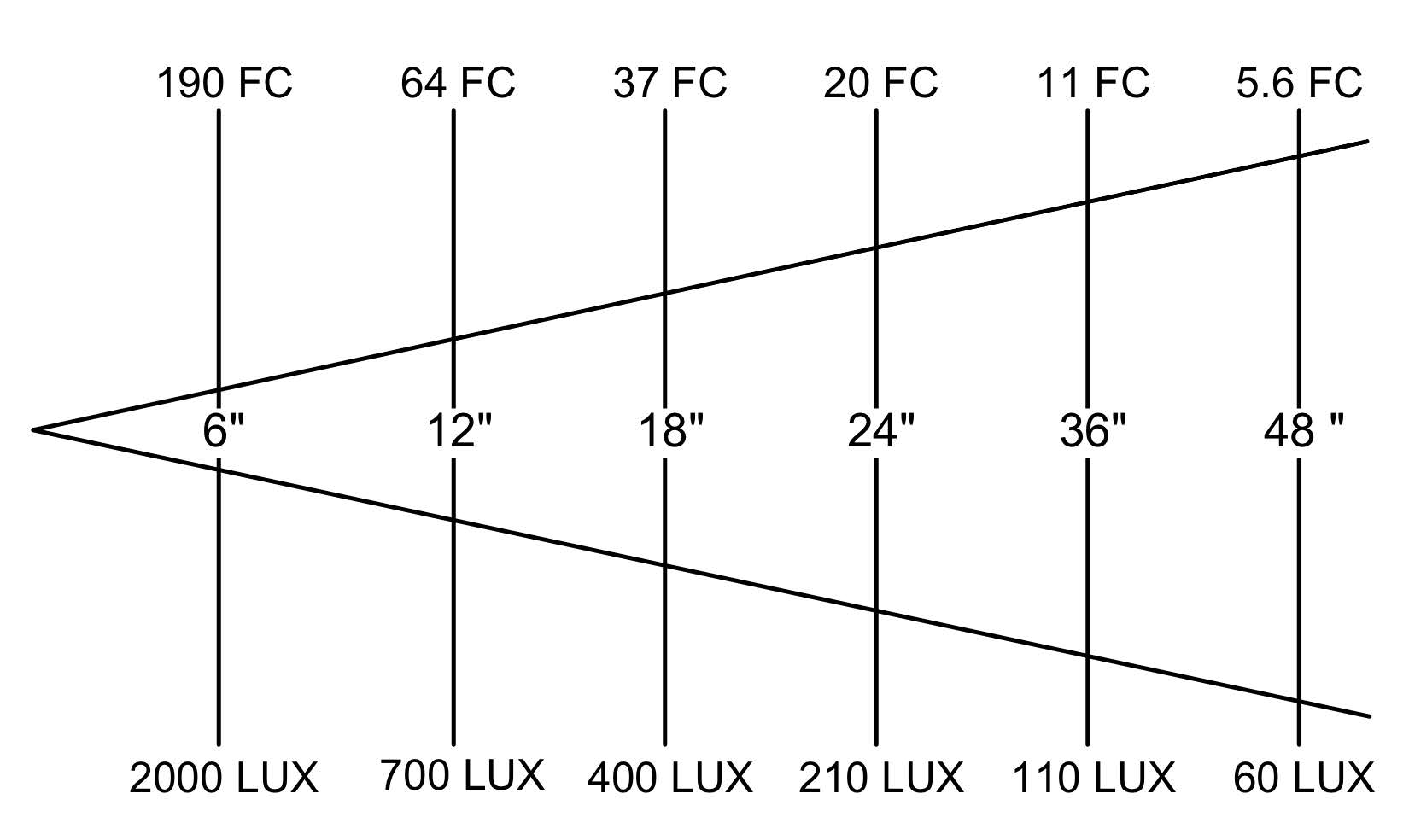Litepad Loop
 Manufacturer: Rosco, Inc.
Manufacturer: Rosco, Inc.Description: LED based augmenting/fill ring/halo light
MSRP: $699 – Base Kit; $1099 – Pro Kit
Expected Release: Available Now
Official Website: Click Here
Special Discount: Regular Kit: Click Here; Pro Kit: Click Here
Review Issue: Issue #80 (10/12)
Review By: Jeremy Hanke
Final Score: 7.0
Having attractive fill lighting is something that can really separate the pros from the amateurs when it comes to cinematography and photography. Close, soft light is most ideal, especially when filming and photographing women (where harsh light and shadow demarcations are undesirable), but the security mirrors which are the human iris have a tendency to reveal artificial shapes in distracting ways. Thus, circle or ring lights are the preferred way to get closeups, as the circles of illumination reflected in the liquid-coated human iris seem natural and organic.
Since these lights are often quite close to the actors’ face, LED lighting is ideal since it excels at soft lighting, uses less energy, and emits almost no heat to the actor.
Rosco has been making a name for themselves for a number of years now with their Litepad LED lighting solutions, and, as such, it was a natural fit for them to release their own version of the ring light called the Litepad Loop.
Ease of Use
First off, the Litepad Loop is quite easy to setup and use. Rosco chose a very robust magnet system that attaches the loop to the front of a special Block-and-Sled, which affixes to the top of your tripod. Your camera then screws into Sled so that the lens protrudes through the ring. Because the front mount is magnetic, you can easily remove the ring when you’re repositioning your camera setup and pop it right back on as soon as your ready for it. (Just make sure that you don’t get the strong magnets too close to any of your memory cards!)
As I was testing this in a few different interview situations, I found it pretty easy to get up and running, although there are so many different pieces in the Pro setup (which we tested) that I did need to use the manual the first time through.
As a reminder, although the Loop is quite a bit more powerful than the other Litepad LEDs, it’s still augmentation or fill lighting, not key lighting, so it is necessary to really get on top of your subject for its use to be effective.
Depth of Options
Depending on which Litepad Loop kit you get, there are a lot of options for this setup.
We tested the $1099 Pro setup which includes:
the Loop, the Main Block, the Sled, the Accessory Collar (with pre-cut Loop Color Pack gels), a Safety Thumb Screw, a 4” L-Bracket, a 4” 15mm Rod, an 8” 15mm rod, a Light Stand plate (if you don’t want to mount it on your camera), a AA battery Holder and mounting adapter, a Right Angle 10’ extension cable, a Litepad Axiom Battery Holder, a single fader dimmer, an AC adapter (with a variety of country specific input blades), a safety cord, a 7/64” Allen key, and a professional storage case.
The $699 basic setup will give you:
the Loop, the Main Block, the Sled, the Accessory Collar, a Safety Thumb Screw, a 4” 15mm Rod, a Right Angle 10’ extension cable, an AC adapter (with a variety of country specific input blades), a safety cord, a 7/64” Allen key, and a pull string storage pouch.
What all these tech specs boil down to is this: the Pro setup is more equipped to do a variety of things, including optional battery operation, optional lightstand mounting, optional extension (with the 8” rods), optional light gelling (for color balance or stylistic reasons), and optional dimming (for light adjustment). The basic setup essentially gives you a tripod-mounted led ring light that can be turned on or off at full power, requiring all other accessories to be purchased ala carte.
As a caveat: even though this rig can run on battery power, it is not designed as a handheld setup. It must be securely and robustly mounted into a tripod or lightstand to work optimally. 2.4 pounds isn’t much weight, but the fact that it has no simple way to be counterbalanced means it’s not something your going to slap on a fig rig, steady cam, or handheld unit.
Unlike some of Rosco’s other litepads, which can be bought in either Tungsten or Daylight color balance options, there is only one color temperature available for the Loop: 5800K. As 5600K is usually considered true daylight, this means the Loop is just a little bluer than true daylight. The color gels, of course, can be used to adjust this temperature when your indoors, but you’ll lose some of the precious brightness of the LEDs in doing this. Rosco has tried to compensate for this by upping the light output of the Loop so you still have decent brightness when your done gelling it.
Personally, I’d love to see Rosco use some of the new LED technology that permits dialing in the color temperature on an LED array so that you can preserve most of the actual Lumens the LEDs are generating, but maybe they’ll do that in a future Litepad release.
Performance
There are some really good points in the performance area of the Loop system and there are some bad points. (Since we were testing the Pro system, some of the things we mention are only present in that package by default.)
The Good:
- Battery/Plugin option is great
- International plugin blades are a great boon for anyone traveling and shooting in other lands
- The precut gels are pretty useful
- The optional Dimmer switch is very impressive in allowing you to mix the light on your subject just right
- The overall weight of the unit is quite light for most applications
- It emits so little heat that your actors are in no danger of being effected by it
- The anticipated 60,000 hour lifespan is pretty impressive
The Bad:
- Its most effective distance is just 6” away, with very quick falloff after that. (The illustration above, provided by Rosco, shows the footcandles of effective light hitting the subject based on the Loop’s distance from the subject. By 4′, there is almost no discernible light hitting the subject.)
- The narrowness of the ring itself can make it easy to vignette your shot if your shooting wide and the front of your lens can’t extend beyond the ring (which happened with some different types of shooting we tested)
- To apply it to most micro cams, you’ll have to get a special third-party adapter
- The inability to mount it directly to the camera via a top accessory shoe means you can’t go handheld with it
- Cord length ratios are way off between the dimmer switch and the plugin adapter. (As such, you have to be awkwardly far from your subject when your adjusting the brightness of your light whenever your using direct current.)
And the Strange:
- Although the system is clearly designed to use the hex driver for adjustment, some of the main areas that can be adjusted on the ring mount require a Philips Screwdriver.
Value
The value of the Loop, as with the other Litepad offerings is a bit of a mixed bag based on what your creative needs are. On one hand, you really can do some nice, painterly lighting with this rig. On the other hand, it’s so soft that you really are only going to regularly use this in those super intense close-ups in a narrative film, or in interviews in documentaries. $700 to $1100 is a lot to pay for something if your only going to use it on rare occasions. As such, if you’re a documentary filmmaker, go ahead and pick this up and use it in all your interviews. Same goes for photographers that specialize in headshots and gaffers who need an additional LED option to go along with the other Rosco Litepads in their kit. However, for many of the narrative filmmakers in our readership, the Litepad Ring is something to rent rather than buy.
Final Comments
For the documentary filmmakers, headshot photographers, and gaffers out there, purchasing the Litepad Ring Pro package is money well spent. For most other filmmakers, however, this is a rental for special scenes or behind-the-scenes vignettes.
|
Breakdown
|
|
|
Ease of Use
|
8.0 |
|
Depth of Options
|
8.0 |
|
Performance
|
6.0 |
|
Value vs. Cost
|
6.0 |
|
Overall Score |
7.0 |






1 Comment
Stands back from the keyboard in amznameet! Thanks!